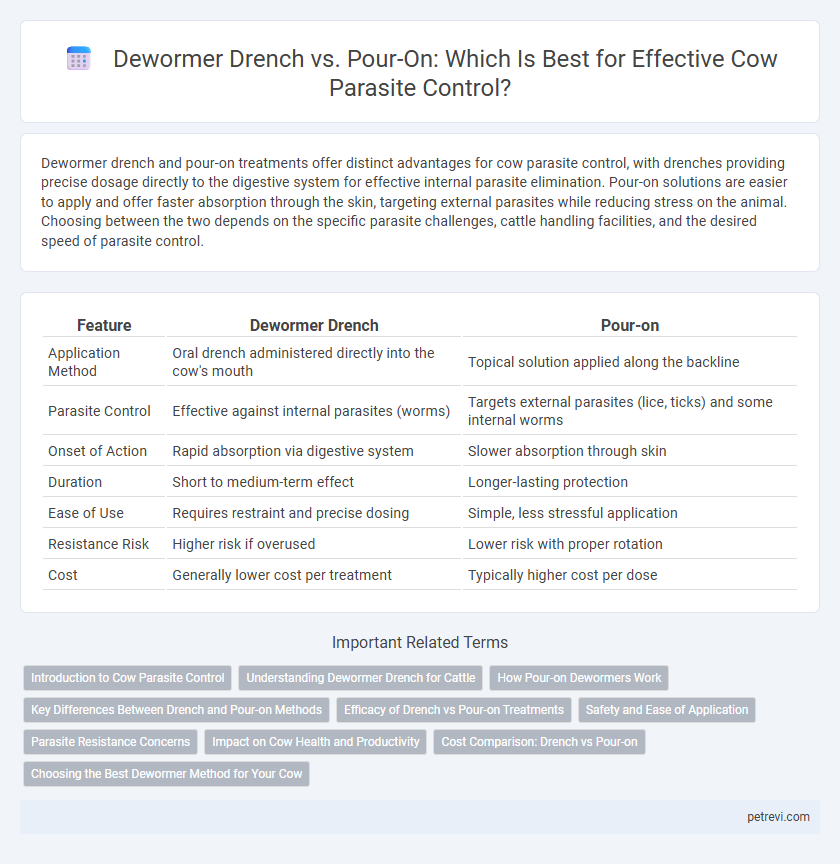Dewormer drench and pour-on treatments offer distinct advantages for cow parasite control, with drenches providing precise dosage directly to the digestive system for effective internal parasite elimination. Pour-on solutions are easier to apply and offer faster absorption through the skin, targeting external parasites while reducing stress on the animal. Choosing between the two depends on the specific parasite challenges, cattle handling facilities, and the desired speed of parasite control.
Table of Comparison
| Feature | Dewormer Drench | Pour-on |
|---|---|---|
| Application Method | Oral drench administered directly into the cow's mouth | Topical solution applied along the backline |
| Parasite Control | Effective against internal parasites (worms) | Targets external parasites (lice, ticks) and some internal worms |
| Onset of Action | Rapid absorption via digestive system | Slower absorption through skin |
| Duration | Short to medium-term effect | Longer-lasting protection |
| Ease of Use | Requires restraint and precise dosing | Simple, less stressful application |
| Resistance Risk | Higher risk if overused | Lower risk with proper rotation |
| Cost | Generally lower cost per treatment | Typically higher cost per dose |
Introduction to Cow Parasite Control
Effective cow parasite control is essential for maintaining herd health and optimizing milk and meat production. Dewormer drench delivers oral medication that targets internal parasites directly in the gastrointestinal tract, while pour-on treatments are applied topically and absorbed through the skin to combat both internal and external parasites. Choosing the appropriate parasite control method depends on parasite species, infestation severity, and cow management practices.
Understanding Dewormer Drench for Cattle
Dewormer drench for cattle delivers an oral antiparasitic solution directly into the cow's digestive system, ensuring rapid absorption and effective elimination of gastrointestinal parasites. This method allows precise dosing based on weight, optimizing parasite control and minimizing resistance risk. Compared to pour-on treatments, drenches provide more consistent efficacy against internal parasites such as roundworms and liver flukes.
How Pour-on Dewormers Work
Pour-on dewormers for cows deliver active ingredients directly onto the animal's skin, allowing it to be absorbed through the hair follicles and into the bloodstream. This method ensures rapid distribution of antiparasitic compounds, targeting internal parasites such as gastrointestinal worms and external parasites like lice and ticks. Pour-on formulations provide an easy, non-invasive application that promotes consistent parasite control across the herd.
Key Differences Between Drench and Pour-on Methods
Dewormer drench delivers oral medication directly to the cow's digestive system, ensuring precise dosage and rapid parasite control, while pour-on treatments are applied topically, absorbed through the skin for a longer-lasting effect. Drench methods provide more immediate parasite eradication, especially effective against internal worms, whereas pour-ons offer convenience and reduced stress, suitable for herd-wide application. Pour-on efficacy can be influenced by environmental factors like rain or mud, whereas drench requires handling individual animals but ensures consistent dosage accuracy.
Efficacy of Drench vs Pour-on Treatments
Dewormer drench treatments for cows provide direct gastrointestinal parasite control by delivering precise dosages orally, ensuring rapid worm elimination and higher overall efficacy against internal parasites. Pour-on treatments offer ease of application and systemic absorption through the skin but may exhibit variable efficacy due to factors like weather conditions, skin thickness, and parasite resistance. Studies indicate that drenches generally maintain superior efficacy in reducing parasite loads, particularly in high-infestation scenarios, compared to pour-on formulations.
Safety and Ease of Application
Dewormer drenches provide precise dosage and effective internal parasite control but require careful handling and restraint of cows, posing moderate risk during application. Pour-on dewormers offer a safer, less stressful method with topical application, minimizing direct contact and reducing the chance of dosage errors. Both methods demand adherence to recommended protocols to ensure safety for the animal and handler while maximizing parasite control efficacy.
Parasite Resistance Concerns
Dewormer drench and pour-on formulations are both used for parasite control in cows but differ in application and absorption rates, impacting resistance development. Parasite resistance concerns arise when pour-on treatments provide inconsistent dosing, allowing parasites to survive and develop tolerance, whereas drenches ensure more accurate dosage through oral administration. Regular rotation of active ingredients and integrated parasite management strategies are critical to minimizing resistance in both treatment methods.
Impact on Cow Health and Productivity
Dewormer drench provides targeted gastrointestinal parasite control, leading to improved nutrient absorption and enhanced weight gain in cows, which positively impacts overall health and productivity. Pour-on treatments offer a convenient, non-invasive application method that ensures uniform parasite control on the skin surface but may have variable efficacy against internal parasites. Effective parasite management through either method reduces anemia and stress in cows, promoting better milk yield and growth rates critical for farm profitability.
Cost Comparison: Drench vs Pour-on
Dewormer drenches for cows typically offer lower upfront costs per dose compared to pour-on formulations, making them more budget-friendly for large herds. Pour-on treatments, while often more expensive per application, reduce labor time and stress by allowing easy topical administration without restraining animals. Evaluating cost-effectiveness requires balancing product price, labor expenses, and the herd size to determine the most economical parasite control method for cattle operations.
Choosing the Best Dewormer Method for Your Cow
Choosing the best dewormer method for your cow depends on factors such as the type of parasites, severity of infestation, and ease of application. Drench solutions provide precise dosing and rapid absorption directly through the digestive tract, making them effective for targeting gastrointestinal worms. Pour-on treatments offer a convenient, stress-free option by applying antiparasitic agents topically, but may vary in effectiveness depending on cow coat condition and environmental factors.
Dewormer Drench vs Pour-on for Cow Parasite Control Infographic

 petrevi.com
petrevi.com